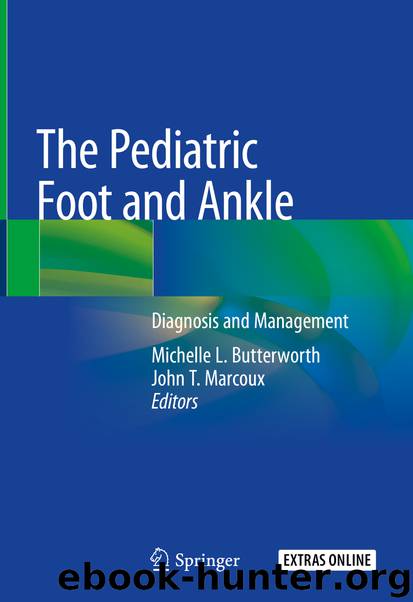The Pediatric Foot and Ankle by Unknown

Author:Unknown
Language: eng
Format: epub
ISBN: 9783030297886
Publisher: Springer International Publishing
Definition of Equinus
DiGiovanni et al., in the Journal of Bone and Joint Surgery (JBJS) 2002, established an evidenced-based definition [9]. The study consisted of 34 symptomatic patients and 34 control patients examining two central points; the amount of ankle joint dorsiflexion in each group and how often the diagnosis was correct using a goniometer [9]. The patient group averaged 4.5° ± 4.5° dorsiflexion with the knee extended and 17.9° ± 9.0° dorsiflexion with the knee flexed [9]. The control group averaged 13.1° ± 8.2° and 22.3° ± 10.9° dorsiflexion, respectively [9]. The difference between the two groups with the knee extended was statistically significant, while the difference between the two groups with the knee flexed was not statistically significant [9]. The percent of the symptomatic patients with less than 5° dorsiflexion was 65%, and the control group was 24%, and for less than 10° dorsiflexion, the totals were 88% and 44%, respectively [9]. The diagnosis was found to be correct with a goniometer, confirmed with an equinometer, for less than 5°of dorsiflexion in 76% of the patient group and 94% of the control group and for less than 10° dorsiflexion in 88% and 79%, respectively [9]. The authors stated, “We have selected <5° of maximal ankle dorsiflexion with the knee in full extension as our definition because it allowed us to diagnose the problem in those who were at risk (symptomatic patients) with fairly good reproducibility (76%) and, more importantly, we were able to reliably avoid (in 94% of the cases) unnecessary treatment of those who were not at risk (asymptomatic people)” [9].
Gatt el al. went one step farther, correlating the static measurement with dynamic function occurring in late midstance prior to heel off [78]. It is well established in late midstance prior to heel off, and 10° to 15° of ankle joint dorsiflexion is required to move the body from behind the foot over the top of the planted foot [78]. Gatt et al.’s study consisted of two groups: group A measured <−5° ankle joint dorsiflexion with the foot maximally supinated, and group B measured ≤ −5° to 0° [78]. In late midstance, ankle joint dorsiflexion measured 4.4° in group A and 13.9° in group B [78]. Clearly, 4.4° is inadequate ankle joint dorsiflexion in late midstance and will require proximal and/or distal compensation. The authors concluded: “There is no relationship between a static diagnosis of ankle dorsiflexion at 0° with dorsiflexion during gait. On the other hand, those subjects with less than −5° of dorsiflexion during static examination did exhibit reduced ankle range of motion during gait” [78].
Silverskoild in 1924 described the technique for examining ankle joint dorsiflexion with the knee extended and flexed to differentiate gastrocnemius equinus from gastrocsoleus equinus [15]. Using the parameters established by Gatt et al., when ankle joint dorsiflexion with the foot maximally supinated is ≤ − 5° with the knee extended and ≥ 10° with the knee flexed, the deformity is a gastrocnemius equinus . If ankle joint dorsiflexion with the foot
Download
This site does not store any files on its server. We only index and link to content provided by other sites. Please contact the content providers to delete copyright contents if any and email us, we'll remove relevant links or contents immediately.
| Administration & Medicine Economics | Allied Health Professions |
| Basic Sciences | Dentistry |
| History | Medical Informatics |
| Medicine | Nursing |
| Pharmacology | Psychology |
| Research | Veterinary Medicine |
Dynamic Alignment Through Imagery by Eric Franklin(4121)
Body Love by Kelly LeVeque(3017)
Barron's AP Calculus by David Bock(1780)
EMT Exam For Dummies with Online Practice by Arthur Hsieh(1654)
The Juice Lady's Remedies for Asthma and Allergies by Cherie Calbom(1608)
Fitness Walking For Dummies by Liz Neporent(1532)
Flight by Elephant(1487)
Extremes: Life, Death and the Limits of the Human Body by Fong Kevin(1486)
McGraw-Hill Nurses Drug Handbook by Patricia Schull(1466)
The Natural First Aid Handbook by Brigitte Mars(1434)
Tell by Major Margaret Witt(1383)
Skin by Unknown(1373)
Seeing Voices by Oliver Sacks(1363)
Born to Walk by James Earls(1285)
The Yoga Bible by Christina Brown(1267)
Cracking the Nursing Interview by Jim Keogh(1254)
First Aid for Colleges and Universities (10th Edition) by Mistovich Joseph J. & Limmer Daniel J. & Karren Keith J. & Hafen Brent Q(1234)
The Advantage by Lencioni Patrick M(1173)
Living Ready Pocket Manual - First Aid: Fundamentals for Survival by James Hubbard(1163)
